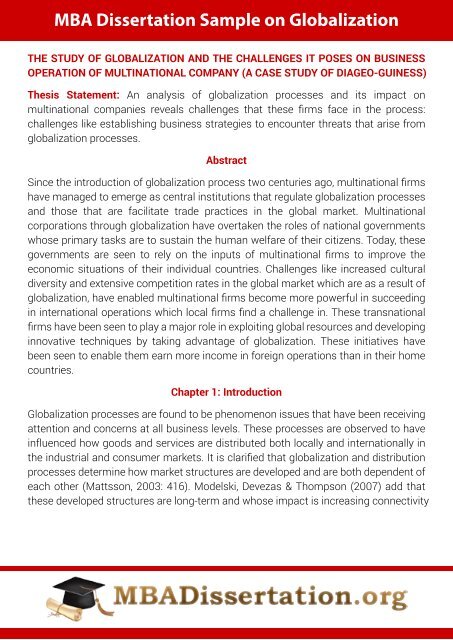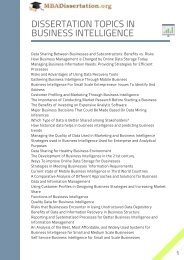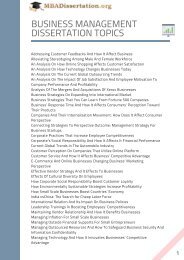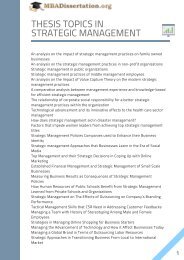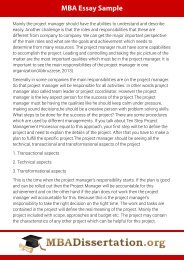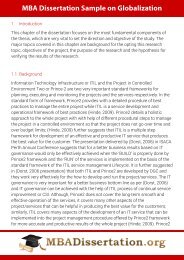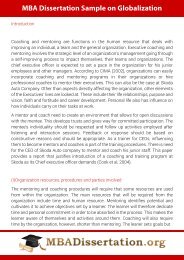MBA Dissertation Sample on Globalization
Take a look at this MBA dissertation Sample on Globalization. More samples here https://www.mbadissertation.org/sample-paper-on-organizational-behaviour/
Take a look at this MBA dissertation Sample on Globalization. More samples here https://www.mbadissertation.org/sample-paper-on-organizational-behaviour/
Create successful ePaper yourself
Turn your PDF publications into a flip-book with our unique Google optimized e-Paper software.
<str<strong>on</strong>g>MBA</str<strong>on</strong>g> <str<strong>on</strong>g>Dissertati<strong>on</strong></str<strong>on</strong>g> <str<strong>on</strong>g>Sample</str<strong>on</strong>g> <strong>on</strong> Globalizati<strong>on</strong><br />
THE STUDY OF GLOBALIZATION AND THE CHALLENGES IT POSES ON BUSINESS<br />
OPERATION OF MULTINATIONAL COMPANY (A CASE STUDY OF DIAGEO-GUINESS)<br />
Thesis Statement: An analysis of globalizati<strong>on</strong> processes and its impact <strong>on</strong><br />
multinati<strong>on</strong>al companies reveals challenges that these firms face in the process:<br />
challenges like establishing business strategies to encounter threats that arise from<br />
globalizati<strong>on</strong> processes.<br />
Abstract<br />
Since the introducti<strong>on</strong> of globalizati<strong>on</strong> process two centuries ago, multinati<strong>on</strong>al firms<br />
have managed to emerge as central instituti<strong>on</strong>s that regulate globalizati<strong>on</strong> processes<br />
and those that are facilitate trade practices in the global market. Multinati<strong>on</strong>al<br />
corporati<strong>on</strong>s through globalizati<strong>on</strong> have overtaken the roles of nati<strong>on</strong>al governments<br />
whose primary tasks are to sustain the human welfare of their citizens. Today, these<br />
governments are seen to rely <strong>on</strong> the inputs of multinati<strong>on</strong>al firms to improve the<br />
ec<strong>on</strong>omic situati<strong>on</strong>s of their individual countries. Challenges like increased cultural<br />
diversity and extensive competiti<strong>on</strong> rates in the global market which are as a result of<br />
globalizati<strong>on</strong>, have enabled multinati<strong>on</strong>al firms become more powerful in succeeding<br />
in internati<strong>on</strong>al operati<strong>on</strong>s which local firms find a challenge in. These transnati<strong>on</strong>al<br />
firms have been seen to play a major role in exploiting global resources and developing<br />
innovative techniques by taking advantage of globalizati<strong>on</strong>. These initiatives have<br />
been seen to enable them earn more income in foreign operati<strong>on</strong>s than in their home<br />
countries.<br />
Chapter 1: Introducti<strong>on</strong><br />
Globalizati<strong>on</strong> processes are found to be phenomen<strong>on</strong> issues that have been receiving<br />
attenti<strong>on</strong> and c<strong>on</strong>cerns at all business levels. These processes are observed to have<br />
influenced how goods and services are distributed both locally and internati<strong>on</strong>ally in<br />
the industrial and c<strong>on</strong>sumer markets. It is clarified that globalizati<strong>on</strong> and distributi<strong>on</strong><br />
processes determine how market structures are developed and are both dependent of<br />
each other (Mattss<strong>on</strong>, 2003: 416). Modelski, Devezas & Thomps<strong>on</strong> (2007) add that<br />
these developed structures are l<strong>on</strong>g-term and whose impact is increasing c<strong>on</strong>nectivity
and sensitivity in business processes. C<strong>on</strong>nectivity are said to be based <strong>on</strong> both local<br />
and internati<strong>on</strong>al dimensi<strong>on</strong>s where organizati<strong>on</strong>al frameworks vary and thus make<br />
business processes become complex in nature (58-59).<br />
This c<strong>on</strong>nectivity ideology is developed to be perceived as establishing a b<strong>on</strong>ded<br />
trading envir<strong>on</strong>ment that operates as <strong>on</strong>e society which is composed of<br />
multiculturalism and varying instituti<strong>on</strong>al comp<strong>on</strong>ents. Ec<strong>on</strong>omic demands are said to<br />
be the primary factors that attract participants to prosper through globalizati<strong>on</strong><br />
processes and thus finding interest in c<strong>on</strong>verging their differences (Bret<strong>on</strong> & Reitz,<br />
2003: 1). Charles (2012) argues that increasing globalizati<strong>on</strong> also attracts business<br />
threats in effort to create business opportunities for companies and thus effective<br />
business strategies have become relevant for firms to gain ec<strong>on</strong>omically (161). This<br />
paper attempts to focus <strong>on</strong> the challenges that globalizati<strong>on</strong> processes pose to<br />
operati<strong>on</strong>s of multinati<strong>on</strong>al companies and in particular Diageo-Guiness Company in<br />
Nigeria.<br />
<str<strong>on</strong>g>MBA</str<strong>on</strong>g><str<strong>on</strong>g>Dissertati<strong>on</strong></str<strong>on</strong>g>.org<br />
Chapter 2: Literature Review<br />
2.1 Introducti<strong>on</strong><br />
Ritzer (2009) informs that globalizati<strong>on</strong> processes are numerous and whose sources<br />
are different. Globalizati<strong>on</strong> is said can be c<strong>on</strong>centrated <strong>on</strong> politics, ec<strong>on</strong>omy,<br />
educati<strong>on</strong>, science and many others (47). The objectives of this paper direct this study<br />
to focus <strong>on</strong>ly <strong>on</strong> studying globalizati<strong>on</strong> in the ec<strong>on</strong>omics c<strong>on</strong>text and how its<br />
challenges impacts <strong>on</strong> the operati<strong>on</strong>s of multinati<strong>on</strong>al companies. In this chapter, the<br />
paper will develop the study based <strong>on</strong> globalizati<strong>on</strong> processes which are driven by<br />
ec<strong>on</strong>omic factors menti<strong>on</strong>ed and explained by Akram, Faheem, Dost & Abdullah<br />
(2011). These factors are noted to include forces of producti<strong>on</strong>, availability of<br />
knowledge and skills, technology and others for the better utilizati<strong>on</strong> of resources,<br />
improvement of ec<strong>on</strong>omic development of countries and human welfare. This, in other<br />
words, enables <strong>on</strong>e appreciate ec<strong>on</strong>omic development as <strong>on</strong>e which is facilitated by<br />
globalizati<strong>on</strong> to maximize the potentials of available resources through increased<br />
cross-border trade operati<strong>on</strong>s (291-292).<br />
2.2 A Study <strong>on</strong> Globalizati<strong>on</strong> Processes in the Ec<strong>on</strong>omics C<strong>on</strong>text<br />
Ali & Reza (2011) recalls that in the past, country governments had been tasked with<br />
the resp<strong>on</strong>sibility of maintaining ec<strong>on</strong>omic welfare and security for their nati<strong>on</strong>als<br />
(1344-1345). Chang (2003) elaborates that this role of the government involved<br />
establishing public enterprises in regi<strong>on</strong>s which had a differential advantage or where<br />
rates of investments required are high (206). According to French (2008) these<br />
traditi<strong>on</strong>s are being overtaken by global processes whose forces are referred to as<br />
globalizati<strong>on</strong> (ix). Kleinert (2004) explains that these forces have transformed
<str<strong>on</strong>g>MBA</str<strong>on</strong>g><str<strong>on</strong>g>Dissertati<strong>on</strong></str<strong>on</strong>g>.org<br />
the ec<strong>on</strong>omic activities of countries into being integrated with other ec<strong>on</strong>omies of the<br />
World. Through globalizati<strong>on</strong>, trade between countries is observed to have increased<br />
remarkably; technology and knowledge transfer have been introduced and have<br />
equally grown; as well as high rates of capital movements realized. Hence distance<br />
between ec<strong>on</strong>omies is no l<strong>on</strong>ger an issue. These three comp<strong>on</strong>ents of globalizati<strong>on</strong><br />
are noted to occasi<strong>on</strong> world’s ec<strong>on</strong>omic integrati<strong>on</strong> process (1).<br />
Crepaz (2001) develops that globalizati<strong>on</strong> processes have extremely limited the roles<br />
of nati<strong>on</strong>al governments in fulfilling its mandate in regards to sustaining ec<strong>on</strong>omic<br />
welfare and security for their citizens. Moreover, it is perceived that with its increasing<br />
growth, democracy of these governments in this c<strong>on</strong>text will be eliminated so<strong>on</strong> (1-2).<br />
A study d<strong>on</strong>e by Joseph, Lee, Chad & James (2004) that focuses <strong>on</strong> the theoretical<br />
aspects relating to the effects of globalizati<strong>on</strong> <strong>on</strong> a country, creates a c<strong>on</strong>ceptualized<br />
framework that explain how globalizati<strong>on</strong> influences the ec<strong>on</strong>omic life of a country. In<br />
the study, it is c<strong>on</strong>veyed that globalizati<strong>on</strong> develops structures that govern inflows and<br />
outflows of products and services that citizens depend <strong>on</strong>, labor, technology and<br />
capital. Moreover, globalizati<strong>on</strong> shows the State’s affairs of a country which determine<br />
how the country becomes ec<strong>on</strong>omically integrated with the rest of the world (251).<br />
Despite integrati<strong>on</strong> of markets in the world and liberati<strong>on</strong> of trade that globalizati<strong>on</strong><br />
has positively c<strong>on</strong>tributed to ec<strong>on</strong>omic developments of countries, the new trends<br />
created by globalizati<strong>on</strong> that involve developing new social aspects of human life are<br />
said to limit efforts by nati<strong>on</strong>al governments in improving the welfare of their citizens.<br />
Such trends include reducti<strong>on</strong> of job opportunities within the country and creating<br />
more of them abroad and others. This is supported by the fact that through<br />
globalizati<strong>on</strong>, markets are integrated for capital, factors of producti<strong>on</strong>, products and<br />
services, and labor (Joseph, et al, 2004: 253).<br />
Chen (2003) c<strong>on</strong>structs that in this global market that is facilitated by globalizati<strong>on</strong>,<br />
players in this arena are sovereign states and multinati<strong>on</strong>al companies. These players<br />
are said to act as regulators of market c<strong>on</strong>diti<strong>on</strong>s to discourage failures. Multinati<strong>on</strong>al<br />
firms are said to take up the role when the sovereign states are weak to regulate<br />
failures in the global market. As it has been explained earlier <strong>on</strong>, governments are not<br />
powerful enough to regulate internati<strong>on</strong>al markets and also, c<strong>on</strong>flicts of interests<br />
am<strong>on</strong>g states make them weaker. Thus, multinati<strong>on</strong>al companies are left to establish<br />
global market rules (1).<br />
Marc (2007) <strong>on</strong> his study <strong>on</strong> the relati<strong>on</strong>ship between nati<strong>on</strong>al governments and<br />
multinati<strong>on</strong>al companies adds that globalizati<strong>on</strong> processes have made the status of<br />
these governments weaker and those of multinati<strong>on</strong>al’s str<strong>on</strong>ger. That is, today, these<br />
transnati<strong>on</strong>al firms are perceived as powerful instituti<strong>on</strong>s as a result of the assets they<br />
possess and thus, governments employ them to enhance their domestic ec<strong>on</strong>omies<br />
(67).
<str<strong>on</strong>g>MBA</str<strong>on</strong>g><str<strong>on</strong>g>Dissertati<strong>on</strong></str<strong>on</strong>g>.org<br />
Globalizati<strong>on</strong> is observed to have spread widely and has influenced most of the<br />
dimensi<strong>on</strong>s of human life. That is politically, culturally, socially and ec<strong>on</strong>omically. On<br />
this basis, D<strong>on</strong>ald (2009) argues that nati<strong>on</strong>al governments must develop policies that<br />
deal with its encroachment. This is facilitated by his study <strong>on</strong> the varying levels of<br />
human development globally and establishment of public policies in reference to<br />
global values which are enhanced by globalizati<strong>on</strong>. The finding of their studies inform<br />
that levels of human development are determined by global social values which are<br />
facilitated through social links and which arouse demands <strong>on</strong> public policy making<br />
issues related to human welfare (229).<br />
Romer (2010) develops these findings by informing that globalizati<strong>on</strong> in the<br />
ec<strong>on</strong>omics c<strong>on</strong>text is a process that is <strong>on</strong>going and countries are becoming more<br />
interdependent for the purposes of their own individual ec<strong>on</strong>omic developments. This<br />
is said to be evidenced by the increasing rate of trade practices am<strong>on</strong>g countries, high<br />
rates of labor mobility and high flows of financial volumes. It is revealed that<br />
globalizati<strong>on</strong> in this c<strong>on</strong>text is improved by reusing ideas to reduce poverty that has<br />
curbed nati<strong>on</strong>s and rather increase their productivities (94).<br />
An analysis is c<strong>on</strong>ducted by Benetti (2000) to establish the present ec<strong>on</strong>omic policies<br />
and plans that some of the weak countries have to improve their ec<strong>on</strong>omies through<br />
this globalizati<strong>on</strong> process in today’s global market. Some of the variables menti<strong>on</strong>ed to<br />
enable a successful study include assessing what differential advantages could these<br />
countries have, what is weakness in the c<strong>on</strong>text of a globalized ec<strong>on</strong>omy and the roles<br />
of nati<strong>on</strong>al governments and private sectors in the face of the new global ec<strong>on</strong>omy<br />
(iv).<br />
The findings of the study by Benetti (2000) informs that through interpretati<strong>on</strong> of<br />
related theoretical aspects and global business operati<strong>on</strong>s, human resource is seen as<br />
the fundamental factor for nati<strong>on</strong>al growth in today’s global ec<strong>on</strong>omy (iv). This finding<br />
is supported by the argument that globalizati<strong>on</strong> is also understood as socializati<strong>on</strong><br />
factor that relates organizati<strong>on</strong>s and people. These relati<strong>on</strong>s are elaborated as<br />
understanding, collaborating and working together under diverse cultures and social<br />
patterns existing in the world today (vii).<br />
Freeman (2006) menti<strong>on</strong>s that the exercise of restricting labor migrati<strong>on</strong>s across<br />
borders is <strong>on</strong>e of the functi<strong>on</strong>s of nati<strong>on</strong>al sovereignty which was realized when<br />
internati<strong>on</strong>al trade barriers were eliminated and trade liberalized. However, flow of<br />
people across-borders in the ec<strong>on</strong>omic sense are found to be the basis of forming a<br />
global ec<strong>on</strong>omy and in c<strong>on</strong>juncti<strong>on</strong> with trade and capital, globalizati<strong>on</strong> forces is able<br />
to facilitate integrati<strong>on</strong> of the world ec<strong>on</strong>omies (145).
<str<strong>on</strong>g>MBA</str<strong>on</strong>g><str<strong>on</strong>g>Dissertati<strong>on</strong></str<strong>on</strong>g>.org<br />
2.3 C<strong>on</strong>ceptual Forces that Drive Operati<strong>on</strong>s of Multinati<strong>on</strong>al Corporati<strong>on</strong>s and How<br />
Globalizati<strong>on</strong> Support this Operati<strong>on</strong>s<br />
According to Mujih (2012), multinati<strong>on</strong>al firms are organizati<strong>on</strong>s that are engaged in<br />
foreign operati<strong>on</strong>s which are owned by citizens of <strong>on</strong>e country but have multiple<br />
branches in foreign lands. It is added that these branches are either wholly or partly<br />
c<strong>on</strong>trolled by the nati<strong>on</strong>als in the home country. These c<strong>on</strong>trols are said to be<br />
management of income generating activities.<br />
Gullen & Garcia-Canal (2010) observes that in today’s increasing competiti<strong>on</strong> in the<br />
global business envir<strong>on</strong>ment, multinati<strong>on</strong>al corporati<strong>on</strong>s are becoming many and<br />
whose home countries are the least globalized. That is, those which are in the process<br />
of developing. In these foreign lands, they operate as joint ventures, alliances or fully<br />
owned branches (1). Akintunde (2008) recalls that a firm becomes internati<strong>on</strong>al when<br />
its business operati<strong>on</strong>s are bey<strong>on</strong>d its nati<strong>on</strong>al borders. These operati<strong>on</strong>s listed to<br />
include producti<strong>on</strong>, staffing, marketing, financing, and others (39).<br />
Thuomrungroje (2004) informs that business opportunities and threats in the global<br />
envir<strong>on</strong>ment are the c<strong>on</strong>sequences of globalizati<strong>on</strong>. These business opportunities are<br />
said to be those that create market and investment potentials and accessibility of<br />
resources. Thus, Thuomrungroje (2004) c<strong>on</strong>firms that globalizati<strong>on</strong> influences the<br />
operati<strong>on</strong>s of multinati<strong>on</strong>al firms and their performance is enhanced through increase<br />
in globalizati<strong>on</strong> (v).<br />
Existing ec<strong>on</strong>omic literatures <strong>on</strong> innovati<strong>on</strong> c<strong>on</strong>cepts are seen to have focused <strong>on</strong> the<br />
c<strong>on</strong>tributi<strong>on</strong>s of globalizati<strong>on</strong> in terms of the mechanism employed and the extent in<br />
which they are used. It is collated that these literatures c<strong>on</strong>vey that much of these<br />
mechanisms have involved c<strong>on</strong>ducting research and development studies <strong>on</strong><br />
business opportunities outside home countries, increase in technological and<br />
knowledge transfers, availability of coordinated labor migrati<strong>on</strong>, and spread of<br />
research and development activities across the globe (Fifarek, 2007: 1).<br />
Fifarek (2007) further explains that the idea of spreading research and development<br />
facilities across the globe was to motivate globalizati<strong>on</strong> processes. That is, identifying<br />
locati<strong>on</strong> advantages in foreign lands for the purposes of maximizing their unique<br />
resources using extraordinary capabilities of foreign investors. Thus, under<br />
globalizati<strong>on</strong>, research and development activities are found to be centralized<br />
functi<strong>on</strong>s of business investors. It is also documented that these activities are<br />
perceived as knowledge seeking techniques of finding resources that are beneficial to<br />
the operati<strong>on</strong>s and objectives of a foreign firm.<br />
These resources are said to be inform of technological capacities, infrastructures,<br />
human resources, factors of producti<strong>on</strong> and many others which are not accessible in<br />
the local business envir<strong>on</strong>ment. This in the process enables the foreign investors to<br />
establish new capabilities and resources which expand their business operati<strong>on</strong>s (1).
<str<strong>on</strong>g>MBA</str<strong>on</strong>g><str<strong>on</strong>g>Dissertati<strong>on</strong></str<strong>on</strong>g>.org<br />
Business threats like increase in competiti<strong>on</strong> levels are caused by globalizati<strong>on</strong>.<br />
Globalizati<strong>on</strong> is appreciated as a phenomen<strong>on</strong> that is driven by trade (Susan & Sara,<br />
2008: 8). Dana (2004) c<strong>on</strong>structs that multinati<strong>on</strong>al firms tend to perform better in<br />
markets that are characterized by high levels of competiti<strong>on</strong>s (471). At this stage, it<br />
can be said that multinati<strong>on</strong>al firms take up a good share of globalizati<strong>on</strong> processes as<br />
explained by Shahrokh (2002: 5). It is informed that multinati<strong>on</strong>al firms embrace<br />
globalizati<strong>on</strong> so that they can gain a superiority status in the business envir<strong>on</strong>ment.<br />
Boyes & Melvin (2007) educates that globalizati<strong>on</strong> is <strong>on</strong>e which is associated with<br />
increasing flow of trading practices across borders and income generating assets.<br />
Also, it is <strong>on</strong>e which is characterized with high mobility of knowledge transfer, people,<br />
and technological advancements. The need for individual ec<strong>on</strong>omic growth is said to<br />
be the driving force behind the development of globalizati<strong>on</strong> and those who have not<br />
embraced this phenomen<strong>on</strong>, have remained poor (437).<br />
Dunning & Narula (2005) adds that globalizati<strong>on</strong> processes have worked to boost<br />
locati<strong>on</strong> advantages of countries in the perspective of foreign investors. In this regard,<br />
governments have found the need of making c<strong>on</strong>tinuous upgrades <strong>on</strong> policies<br />
governing determinants of foreign investments in their individual country. This is said<br />
to be a need of keeping up the pace of ec<strong>on</strong>omically developing their individual country<br />
through foreign investments. In this regard, it is informed that through studies made<br />
<strong>on</strong> the growth of multinati<strong>on</strong>al companies globally, globalizati<strong>on</strong> has made ec<strong>on</strong>omic<br />
development of countries become unequal. It is claimed that <strong>on</strong>e of the major reas<strong>on</strong><br />
for this is failure of some countries failing to embrace globalizati<strong>on</strong> (1).<br />
Globalizati<strong>on</strong> has been menti<strong>on</strong>ed to be associated with transfer of technological<br />
c<strong>on</strong>cepts, knowledge, and management capabilities which encourage differential<br />
advantages in the business market. This is noted to be facilitated by multinati<strong>on</strong>al<br />
firms and other foreign direct investments (FDI). Thus, the ability to attract<br />
multinati<strong>on</strong>al firms can be said to be associated with the level of globalizati<strong>on</strong> a<br />
country is at (Dunning & Narula, 2005: 1-2). Sim<strong>on</strong>a (2009) c<strong>on</strong>firms this by<br />
articulating that multinati<strong>on</strong>al firms have today become the top ec<strong>on</strong>omic units<br />
around the world. Due to globalizati<strong>on</strong>, these units are said to have varying sizes,<br />
activities, roles, policies, significance and type of property. These units are currently<br />
perceived as those that bare business capital and determine how flow of this capital is<br />
to be structured in the global business envir<strong>on</strong>ment (23).<br />
Kozeta & Klodiana (2012) c<strong>on</strong>structs that through globalizati<strong>on</strong>, multinati<strong>on</strong>al<br />
companies have found support in the establishment of their investments in various<br />
countries in the perspective that the world market is borderless a company has the<br />
right to compete in this market with others. On this basis, multinati<strong>on</strong>al firms have<br />
managed to make their producti<strong>on</strong>s in different countries and make sales to the rest of<br />
the world (277).
This, in other words, as explained by Kornecki & Rhoades (2007), operati<strong>on</strong>s of<br />
multinati<strong>on</strong>al companies through globalizati<strong>on</strong> involve stimulating ec<strong>on</strong>omic growth<br />
by increasing productivity, innovati<strong>on</strong> and employment rates and technology transfers<br />
in countries around the world. Thus globalizati<strong>on</strong> in this case is said to enable freedom<br />
to make investments which capitalize <strong>on</strong> the differential advantages of countries and<br />
to trade globally <strong>on</strong> activities that generate more returns for investors (113-114).<br />
<str<strong>on</strong>g>MBA</str<strong>on</strong>g><str<strong>on</strong>g>Dissertati<strong>on</strong></str<strong>on</strong>g>.org<br />
2.4 Threats that Arise from Globalizati<strong>on</strong> Processes and How they Challenge the<br />
Operati<strong>on</strong>s of Multinati<strong>on</strong>al Companies<br />
Cullen & Parboteeah (2013) acknowledges that inequalities in ec<strong>on</strong>omic growth<br />
brought about by globalizati<strong>on</strong> processes have attracted business threats for<br />
companies in the global market. As menti<strong>on</strong>ed earlier <strong>on</strong> in this paper, threats like<br />
increasing competiti<strong>on</strong> levels especially from developing and transiti<strong>on</strong>ing ec<strong>on</strong>omies.<br />
Due to increase in globalizati<strong>on</strong>, products, customers and standards have become<br />
global. That is through sophisticated technologies that have enables operati<strong>on</strong>s<br />
around the world manageable and accessible. For effective operati<strong>on</strong>s of<br />
multinati<strong>on</strong>al companies, managers of these firms need to have the ability to<br />
appreciate how business processes are changing rapidly due to globalizati<strong>on</strong> (26).<br />
Another challenge affecting business practices is increase in cultural diversities.<br />
These diversities bring with them varying demands related to foreign laws and<br />
religious practices which influence how management of foreign firms like<br />
multinati<strong>on</strong>al companies are c<strong>on</strong>ducted. It is argued that a nati<strong>on</strong>al culture supports<br />
well the development of a multinati<strong>on</strong>al firm but those which are foreign are said to<br />
outdo the domestic <strong>on</strong>e in which the local societies are after protecting (Aswathappa,<br />
2007: 3; Cullen & Parboteeah, 2013: 26).<br />
Vijesh & Rahul (2013) add that employees’ working c<strong>on</strong>ducts are greatly influenced by<br />
the cultural dimensi<strong>on</strong>s of a company. To develop a professi<strong>on</strong>al way of working,<br />
companies are demanded to develop team work processes that are driven by a<br />
comm<strong>on</strong> goal. In the case of multinati<strong>on</strong>al corporati<strong>on</strong>s, the fact that the operati<strong>on</strong>s of<br />
these firms are located in many locati<strong>on</strong>s, they are faced with similar challenges of<br />
establishing a multi-nati<strong>on</strong>al teamwork that ensures that all employees work in<br />
comfort and professi<strong>on</strong>ally. This is proofed to be a challenge by the results of a study<br />
d<strong>on</strong>e <strong>on</strong> measuring the level of employees’ comfort in different countries which<br />
showed that these comfort levels varied am<strong>on</strong>g subsidiary companies of a<br />
multinati<strong>on</strong>al company (104).
<str<strong>on</strong>g>MBA</str<strong>on</strong>g><str<strong>on</strong>g>Dissertati<strong>on</strong></str<strong>on</strong>g>.org<br />
2.5 Business Strategies employed by Multinati<strong>on</strong>al Firms to Encounter Challenges<br />
Posed by Threats Arising from Increased Globalizati<strong>on</strong><br />
Tallman (2010) observes that today, due to increasing rate of globalizati<strong>on</strong>, business<br />
strategies for companies have become global strategies. This is because;<br />
organizati<strong>on</strong>, innovati<strong>on</strong>, market and competiti<strong>on</strong> situati<strong>on</strong>s presently are global. In<br />
this aspect, it is collated that much of these operati<strong>on</strong>s are associated with activities<br />
of multinati<strong>on</strong>al companies. These companies find themselves competing with other<br />
firms with the same capacities they have. Global business strategies for multinati<strong>on</strong>al<br />
firms are said to involve making investments strategically in many countries around<br />
the globe. It is revealed that these strategies of multinati<strong>on</strong>al firms <strong>on</strong>ly apply in<br />
subsidiary firms that are spread widely across the globe (Tallman, 2010).<br />
Rajdeep, Murali & Robert (2008) elaborate that global strategies for these firms are<br />
those that underscore the need of becoming more flexible, efficient and c<strong>on</strong>tinuous<br />
learning (886). It is further explained that the issue about becoming more efficient<br />
involves a number of opti<strong>on</strong>s which are: dispersi<strong>on</strong> of producti<strong>on</strong> activities in locati<strong>on</strong>s<br />
which have the best differential advantage in the market; dispersi<strong>on</strong> of value chain<br />
processes like marketing, procurement, producti<strong>on</strong>, technology, sales and others, and<br />
the idea of product standardizati<strong>on</strong> and diversificati<strong>on</strong> as well (Noguez, 2003: 119).<br />
Peng (2013) also adds <strong>on</strong> this by explaining about the element of innovativeness that<br />
multinati<strong>on</strong>al companies employ to gain a differential advantage. It is educated that<br />
these firms manufacture new products in already developed countries then either<br />
make simplificati<strong>on</strong>s <strong>on</strong> these products for markets in developing countries or localize<br />
them. These simplificati<strong>on</strong>s are said to be targeted towards reducing costs while<br />
localizing them means having these expensive products for high class customers (8).<br />
Global business strategies in relati<strong>on</strong> to locati<strong>on</strong> advantages are also expounded by<br />
Jiatao & Deborah (2008). It is informed that multinati<strong>on</strong>al firms maximize <strong>on</strong> this due<br />
to the fact that a country’s unique resources cannot be imitated or become<br />
transferable across borders. In this c<strong>on</strong>text, it is educated that the global diversity<br />
strategies of multinati<strong>on</strong>al firms are regulated by the size of the local market and legal<br />
c<strong>on</strong>diti<strong>on</strong>s which eventually have an influence <strong>on</strong> their performance levels.<br />
It is underscored that internati<strong>on</strong>al diversificati<strong>on</strong> is high <strong>on</strong> multinati<strong>on</strong>als originating<br />
from countries whose envir<strong>on</strong>ment are associated with civil laws. That is, it is<br />
explained that before a firm extends abroad, it initially develops within the local c<strong>on</strong>text<br />
which is found to play a major role in modeling its strategic business approaches.<br />
Hence, the probabilities of gaining similar competitive advantages abroad as those<br />
realized domestically are said to be high (667-668).
<str<strong>on</strong>g>MBA</str<strong>on</strong>g><str<strong>on</strong>g>Dissertati<strong>on</strong></str<strong>on</strong>g>.org<br />
2.6 Multinati<strong>on</strong>al Corporati<strong>on</strong>s Perceived as Business Strategies by Local Firms in<br />
their Effort to Manage Challenges Brought About by Globalizati<strong>on</strong><br />
As menti<strong>on</strong>ed earlier <strong>on</strong> in this paper, multinati<strong>on</strong>al firms go global for the purposes of<br />
securing a superiority positi<strong>on</strong> in value creati<strong>on</strong> in the global c<strong>on</strong>text. This value<br />
creati<strong>on</strong> process is said to involve proper management of resources, competiti<strong>on</strong><br />
management and developing good customer relati<strong>on</strong>ships. Thus, operati<strong>on</strong>s of<br />
multinati<strong>on</strong>al firms shape industrial and competiti<strong>on</strong> structures in the global business<br />
envir<strong>on</strong>ment. On this basis, making preference to operate as multinati<strong>on</strong>al firms is<br />
itself a global strategy in succeeding in the internati<strong>on</strong>al arena (Violeta, Jasmina &<br />
Sladjana, 2010).<br />
An<strong>on</strong>ymous (2005) acknowledges this opti<strong>on</strong> that local business c<strong>on</strong>sider in<br />
operating as multinati<strong>on</strong>al firms. This is through the informati<strong>on</strong> provided about the<br />
findings of a recent survey <strong>on</strong> the increasing business practices globally. It is<br />
documented that 85percent of these businesses have succeeded as multinati<strong>on</strong>al<br />
corporati<strong>on</strong>s (24). Michael, Lee & Emre (2002) argues in support of this finding by<br />
noting that companies that have g<strong>on</strong>e global do not have sufficient resources to<br />
effectively compete in the world market. To enable them succeed, they develop<br />
networking systems that assist them gain accessibility to the needed resources (353).<br />
Yad<strong>on</strong>g & Justin (2010) establish a theoretical perspective based <strong>on</strong> global business<br />
strategies for multinati<strong>on</strong>al firms and local organizati<strong>on</strong>s in their resp<strong>on</strong>d to threats<br />
arising from increased globalizati<strong>on</strong> in the business envir<strong>on</strong>ment. In their study, they<br />
clarify that global strategies for multinati<strong>on</strong>al firms are different from those of the local<br />
business units since management capacities and percepti<strong>on</strong>s about the business<br />
envir<strong>on</strong>ment are not the same.<br />
The findings of their study inform that global strategies for multinati<strong>on</strong>al firms are<br />
associated with complexities, hostility and dynamism of the global business<br />
envir<strong>on</strong>ment. That is, these firms develop and implement aggressive strategies that<br />
fight back the dynamics and complexities of this envir<strong>on</strong>ment for the purposes of<br />
enabling them gain a superiority performance. For local enterprises, these strategies<br />
are more of being defensive and often include looking for support from the<br />
government to enable them to succeed during ec<strong>on</strong>omic changes.<br />
2.7 Chapter Summary<br />
Globalizati<strong>on</strong> processes have many positive c<strong>on</strong>tributi<strong>on</strong>s to the welfare of<br />
organizati<strong>on</strong>s in the internati<strong>on</strong>al arena and which promotes ec<strong>on</strong>omic growth of<br />
countries. Globalizati<strong>on</strong> phenomen<strong>on</strong> is employed as a tool that is aimed at developing<br />
a wealthier world using integrated ec<strong>on</strong>omies of countries around the globe. In the<br />
process, innovati<strong>on</strong>s are created and resources are exploited following locati<strong>on</strong><br />
advantages c<strong>on</strong>cept. Thus, globalizati<strong>on</strong> has been understood as <strong>on</strong>e that rewards
good corporate governance, fosters universal participati<strong>on</strong> and cooperative efforts,<br />
creates new markets, and enhances universal development aspects. Nevertheless,<br />
challenges are realized in these processes.<br />
Challenges like unequal human developments around the globe which are<br />
characterized by social and ec<strong>on</strong>omic inequalities which seem to widen in this<br />
c<strong>on</strong>text. Nati<strong>on</strong>al governments have been found to be limited in solving this due to the<br />
hindrances that have been posed by increased globalizati<strong>on</strong>. Other challenges like<br />
increased cultural diversity have been menti<strong>on</strong>ed in the perspective of the operati<strong>on</strong>s<br />
of multinati<strong>on</strong>al firms. This has been understood as <strong>on</strong>e that demands effective team<br />
work processes that work professi<strong>on</strong>ally to achieve <strong>on</strong>e comm<strong>on</strong> goal. This demand<br />
has been appreciated as <strong>on</strong>e which is tasking for the management of operati<strong>on</strong>s<br />
especially when subsidiary firms are many and are located in different parts of the<br />
world. These challenges menti<strong>on</strong>ed have been selected according to the scope of this<br />
study. That is, those which influence the operati<strong>on</strong>s of multinati<strong>on</strong>al firms and<br />
increase in competiti<strong>on</strong> levels is <strong>on</strong>e that has been found to have a significant impact<br />
<strong>on</strong> the operati<strong>on</strong>s of these firms. That is, making them str<strong>on</strong>ger in the market and<br />
being employed as business strategies by nati<strong>on</strong>al governments to enable their local<br />
firms succeed in the highly competitive global market.<br />
<str<strong>on</strong>g>MBA</str<strong>on</strong>g><str<strong>on</strong>g>Dissertati<strong>on</strong></str<strong>on</strong>g>.org<br />
Chapter 3: Research Hypothesis<br />
The primary purpose of this study is to make a study <strong>on</strong> the processes of globalizati<strong>on</strong><br />
and the challenges this phenomen<strong>on</strong> poses <strong>on</strong> the operati<strong>on</strong>s of multinati<strong>on</strong>al<br />
companies. From the literature review secti<strong>on</strong>, it has been c<strong>on</strong>ceptualized that the rate<br />
of globalizati<strong>on</strong> increases by its c<strong>on</strong>tinuous support <strong>on</strong> the operati<strong>on</strong>s of multinati<strong>on</strong>al<br />
corporati<strong>on</strong>s. The challenges that arise from increased globalizati<strong>on</strong> are cultural<br />
diversity and increased competiti<strong>on</strong> rates in which multinati<strong>on</strong>al firms have been<br />
understood to find strength to succeed through their effective global strategies.<br />
The findings of this paper are to make a c<strong>on</strong>tributi<strong>on</strong> to the existing literatures that<br />
have a relati<strong>on</strong> to this topic. This is by c<strong>on</strong>sidering a case study of Diageo-Guiness a<br />
multinati<strong>on</strong>al company in Nigeria which explores how the arguments in this paper are<br />
applicable to the real business world.<br />
Chapter 4: A Case Study <strong>on</strong> the Operati<strong>on</strong>s of Diageo-Guinness<br />
Business strategies are also said to be unique for every organizati<strong>on</strong> and for this<br />
purpose, this paper attempts to explore the operati<strong>on</strong>s of Diageo-Guiness, a<br />
multinati<strong>on</strong>al company in Nigeria and identify the business strategies it has in place<br />
for its success in the global arena.
4.1 Company’s Background<br />
Diageo is described as a multinati<strong>on</strong>al corporati<strong>on</strong> that is engaged in the producti<strong>on</strong> of<br />
premium drinks in the alcohol industry that includes beer, wines and spirits. Some of<br />
the brands listed for this firm are Windsor, Bushmills whiskies, Crown Royal, Johnnie<br />
Walker, Smirnoff, Captain Morgan and many more. The operati<strong>on</strong>s of this firm have<br />
been in existence for a number of generati<strong>on</strong>s and the firm has been succeeding<br />
through c<strong>on</strong>tinuous innovati<strong>on</strong>s that match the needs and preferences of its market.<br />
Diageo-Guiness has also managed to establish its subsidiary companies across the<br />
world where people around the globe enjoy its huge range of products at anytime they<br />
need to. The number of countries that this firm has invested in adds up to 180 of which<br />
manufacturing, marketing, distributi<strong>on</strong>, and other value adding chains are spread<br />
am<strong>on</strong>g these countries strategically (Diageo, 2014).<br />
Diageo (2014) elaborates <strong>on</strong> the distributi<strong>on</strong> of these value adding chains. It is<br />
informed that manufacturing plants are located in subsidiary companies located in<br />
America, the Great Britain, Spain, Canada, Africa, India, Australia and others. Sales,<br />
marketing and distributi<strong>on</strong> centers are said to be locate in geographical regi<strong>on</strong>s<br />
including Western Europe, North America, Eastern Europe, Turkey and others. The<br />
divergence of these producti<strong>on</strong> systems for Diageo-Guiness are said to include<br />
packing, distillati<strong>on</strong>, malting, maturati<strong>on</strong>, wineries and others. These subsidiary<br />
companies are noted to be wholly and partially owned by Diageo-Guiness. That is<br />
80percent are fully owned and 20percent are managed through c<strong>on</strong>tractual<br />
agreements or joint ventures.<br />
<str<strong>on</strong>g>MBA</str<strong>on</strong>g><str<strong>on</strong>g>Dissertati<strong>on</strong></str<strong>on</strong>g>.org<br />
4.2 Business Operati<strong>on</strong>s of Diageo-Guiness and How Globalizati<strong>on</strong> Processes Have<br />
Impacted its Operati<strong>on</strong>s<br />
Diageo-Guiness found favorable locati<strong>on</strong>s with certain advantages that are sufficient<br />
enough for the successful operati<strong>on</strong>s of its business. These advantages include<br />
availability of market power, lower producti<strong>on</strong> costs, availability of producti<strong>on</strong><br />
resources, reliable networking that enable the firm enter new foreign markets and<br />
others (Forsgren, 2013). Thus the global strategy for this multinati<strong>on</strong>al firm in<br />
producti<strong>on</strong> and distributi<strong>on</strong> is the dispersi<strong>on</strong> of their assets and sales using business<br />
approaches that are home grown. These approaches have enabled the firm to adapt to<br />
business activities that are in foreign lands and its ability to select suitable locati<strong>on</strong>s<br />
for its business operati<strong>on</strong>s (Alan & Alain, 2008: 397).<br />
Diageo-Guiness, a British multinati<strong>on</strong>al firm whose head offices are in L<strong>on</strong>d<strong>on</strong> is listed<br />
as <strong>on</strong>e of the largest manufacturers of alcoholic drinks. Arthur Guiness a brewer is<br />
noted to have begun this business in 1759 and when the business was fully<br />
operati<strong>on</strong>al, Guiness is said to have began developing a reputati<strong>on</strong> in civic affairs and<br />
in business. This eventually enabled his business to begin expanding its operati<strong>on</strong>s
<str<strong>on</strong>g>MBA</str<strong>on</strong>g><str<strong>on</strong>g>Dissertati<strong>on</strong></str<strong>on</strong>g>.org<br />
from Dublin to the surrounding town. His engagements in public affairs, he supported<br />
local laws and reform in his country. His business is informed to have begun booming<br />
from the end of Napole<strong>on</strong>ic Wars and c<strong>on</strong>tinued to grow even after its operati<strong>on</strong>s were<br />
shifted to England due to the myths that surrounded the manufactured drinks. These<br />
myths that were based <strong>on</strong> positive health issues formed the basis of the company’s<br />
marketing efforts (Diageo, 2014).<br />
From England, the firm now began to open up branches in other parts of the world. The<br />
countries that have warm climates are said to have been mostly preferred. Nigeria was<br />
<strong>on</strong>e of the first brewery stati<strong>on</strong> to be c<strong>on</strong>structed then Malaysia, Ghana, Camero<strong>on</strong><br />
and others followed. In these regi<strong>on</strong>s, new products like Irish Ale were produced and<br />
sold to markets in Britain and France. The firm is also noted to have engaged in<br />
product diversificati<strong>on</strong> by c<strong>on</strong>sidering business ventures in plastic, pharmaceuticals<br />
and other industries to counteract the declining market for their products like stout<br />
(Diageo, 2014).<br />
This British multinati<strong>on</strong>al firm is found to have begun penetrating the internati<strong>on</strong>al<br />
markets when globalizati<strong>on</strong> was increasingly becoming popularized with the high<br />
rates of cross border ec<strong>on</strong>omic activities were being facilitated by multinati<strong>on</strong>al<br />
companies from 1960s (Heinecke, 2011: 12). During this period, expansi<strong>on</strong> to other<br />
countries is noted to have been greatly challenged by distance and culture difference.<br />
These challenges demanded adaptati<strong>on</strong> to foreign investments for the purposes of<br />
reducing market uncertainties. The incentives provided by the host countries are said<br />
to have supported these adaptati<strong>on</strong> and even entry processes that hindered entry to<br />
foreign markets (Verbeke & Merchant, 2012: 263).<br />
As seen earlier, the expansi<strong>on</strong> to foreign envir<strong>on</strong>ments for Diageo-Guiness is not <strong>on</strong>ly<br />
market driven by also for additi<strong>on</strong> to value chain processes. Thus, the c<strong>on</strong>siderati<strong>on</strong> of<br />
a country’s unique resources which are not movable became significant in creating the<br />
potential to globalize for the purposes of maximizing utilizati<strong>on</strong> of these resources<br />
(Verbeke & Merchant, 2012: 263-264). From the study, it is appreciated that locati<strong>on</strong><br />
c<strong>on</strong>centrati<strong>on</strong> and dispersi<strong>on</strong> for Diageo-Guiness were initiated following potential<br />
income earning investments in new producti<strong>on</strong> assets and through joint ventures with<br />
foreign firms. This business c<strong>on</strong>cept is explained to involve splitting up business<br />
assets to become sources of earning more returns for the firm. These assets are noted<br />
to include knowledge transfer, business reputati<strong>on</strong>, and brand name of the company,<br />
producti<strong>on</strong> processes and others (Navaretti, 2004: 24-25).<br />
This business approach of changing from a regi<strong>on</strong>al to an internati<strong>on</strong>al market<br />
approach can be said to be global business strategy where the firm positi<strong>on</strong>s it-self by<br />
establishing its internati<strong>on</strong>al scope. Thus, just like many other multinati<strong>on</strong>al firms,<br />
Diageo-Guiness is a firm that is a global business whose operati<strong>on</strong>s are at least in<br />
each of part of the world. These expansi<strong>on</strong> practices are facilitated by globalizati<strong>on</strong><br />
which links product differentials and producti<strong>on</strong> mix with significant locati<strong>on</strong><br />
advantages (Rugman, 2005: 224-226, 231).
<str<strong>on</strong>g>MBA</str<strong>on</strong>g><str<strong>on</strong>g>Dissertati<strong>on</strong></str<strong>on</strong>g>.org<br />
4.3 Challenges Arising from Globalizati<strong>on</strong> and Business Strategies for Diageo-Guiness<br />
to overcome them<br />
Competiti<strong>on</strong> structures in the alcohol beverage industry are said to be extensive in<br />
local firms <strong>on</strong>ly and c<strong>on</strong>sumers in this industry are observed to be making selecti<strong>on</strong>s<br />
from a huge range of products produced by large companies. It is informed that from<br />
the past, business strategies that enabled entrepreneurs in this industry to succeed<br />
involved establishing brands and business reputati<strong>on</strong>s globally as well as engaging in<br />
str<strong>on</strong>g business partnerships and marketing strategies in the internati<strong>on</strong>al arena<br />
(Mayhofer, 2012: 37-39).<br />
Business strategies for firms in the alcohol beverage industry are said to be two. That<br />
is specializati<strong>on</strong> and diversificati<strong>on</strong>. Specializati<strong>on</strong> is explained to involve producing<br />
products that are meant for a particular segment of the market. Product diversificati<strong>on</strong><br />
is said to be c<strong>on</strong>sidered because it allows firms to add more value in the alcohol<br />
beverage market and others. And also for the purposes of spreading related costs<br />
(Mayhofer, 2012: 40-41).<br />
From this finding it is appreciated that business operati<strong>on</strong>s of large companies like<br />
Diageo-Guiness in this industry are employed as business strategies for local firms<br />
operating in their host countries. It is also c<strong>on</strong>veyed that the operati<strong>on</strong>s of<br />
Diageo-Guiness involve management of multiple subsidiary firms using shared<br />
business strategies and goals. Such efforts are said to make significant c<strong>on</strong>tributi<strong>on</strong>s<br />
as other multinati<strong>on</strong>al firms in establishing pillars of c<strong>on</strong>ducting internati<strong>on</strong>al business<br />
successfully. That is, through the operati<strong>on</strong>s of Diageo-Guiness, host countries have<br />
managed to overcome their marketing imperfecti<strong>on</strong>s and have realized significant<br />
ec<strong>on</strong>omic growth (Banalieva, 2007: 8).<br />
As said before <strong>on</strong> this paper, these imperfecti<strong>on</strong>s are created from increased<br />
competiti<strong>on</strong>s, existing market structures, changing market needs and preferences that<br />
local firms are unable to manage. The use of locati<strong>on</strong> advantage and other unique<br />
resources that Diageo-Guiness has and which are transferable to its subsidiary firms,<br />
have made it hard for other competitive firms to copy and thus making this firm gain<br />
and sustain a competitive advantage across the globe. These unique resources for<br />
Diageo-Guiness include expertise skills in terms of producti<strong>on</strong>, ec<strong>on</strong>omies of scope<br />
organizati<strong>on</strong> and distributi<strong>on</strong>, marketing abilities, ec<strong>on</strong>omies of scale and others.<br />
These resources, in additi<strong>on</strong> to locati<strong>on</strong> advantages are claimed to have made this firm<br />
realize success in its operati<strong>on</strong>s by overcoming imperfecti<strong>on</strong>s found in the business<br />
envir<strong>on</strong>ment (Banalieva, 2007: 8-10).<br />
Diageo-Guiness like other multinati<strong>on</strong>al firms operates in five operati<strong>on</strong>al structures as<br />
part of their business strategy. That is, local structure, global divisi<strong>on</strong>, operati<strong>on</strong>al<br />
divisi<strong>on</strong>s, geographical divisi<strong>on</strong>s and product divisi<strong>on</strong>s. As explained before,<br />
geographical divisi<strong>on</strong>s are related to operati<strong>on</strong>al and product divisi<strong>on</strong>s (producti<strong>on</strong>,
marketing, distributi<strong>on</strong>, sales and others). Hence, it can be developed that the global<br />
strategy for Diageo-Guiness is established from these structures that c<strong>on</strong>sist of<br />
transnati<strong>on</strong>al operati<strong>on</strong>s that are strategically determined. That is in terms of market<br />
size, organizati<strong>on</strong>’s capabilities, customers’ needs and preferences (Cheng, Maitland &<br />
Nicholas, 2009: 9-11).<br />
These global business strategies have made Diageo-Guiness be recognized for its<br />
efficient superiority in this industry. It is c<strong>on</strong>sidered as a vehicle that transfers relevant<br />
knowledge and skills across borders in the industry and in business in general. This<br />
knowledge and skills transfer is observed to be most effective in wholly owned<br />
subsidiaries (Bruce & Udo, 1993: 625). The performance results of this company also<br />
add to the findings of the study d<strong>on</strong>e by Stephen, Michael and David (2004) which<br />
c<strong>on</strong>vey that business strategy structures and resources do have an impact <strong>on</strong> the<br />
performance of a company in foreign markets (107).<br />
<str<strong>on</strong>g>MBA</str<strong>on</strong>g><str<strong>on</strong>g>Dissertati<strong>on</strong></str<strong>on</strong>g>.org<br />
4.4 Theoretical Frame Works Related to the Findings of this Study<br />
John, John, Sarianna (2010) in their study attempt to establish a theoretical<br />
framework. This is said to be achieved from evoluti<strong>on</strong>s of creative activities of<br />
multinati<strong>on</strong>al companies and their related firms which have as well made evoluti<strong>on</strong>s to<br />
take place in the global business envir<strong>on</strong>ment. It is documented that subsidiaries for<br />
multinati<strong>on</strong>al firms are the core influencers of local business entrepreneurships. That<br />
is, these entrepreneurship models are shaped by the decentralized forms of business<br />
activities that are experimented and c<strong>on</strong>ducted in the corporate networks existing in<br />
the internati<strong>on</strong>al arena. This, in other words, entails creating competency levels <strong>on</strong><br />
local firms and which is said to form the basis of understanding the significance of<br />
multinati<strong>on</strong>al companies <strong>on</strong> ec<strong>on</strong>omic policies generated by a country (567).<br />
Baumuller (2007) explains another theory that claims that a character of a company is<br />
determined from the results obtained from differentiated resources which are<br />
coordinated purposively to achieve a comm<strong>on</strong> goal when acting <strong>on</strong> a given set of<br />
activities. Also, organizati<strong>on</strong>s are social groups that organize their efforts in attempt to<br />
survive and adapt to certain circumstances that have a significant influence in their<br />
existence (32-33).<br />
Another theoretical framework relates to internati<strong>on</strong>al theory whereby locati<strong>on</strong><br />
advantage of a country and a firm’s specific advantage (FSA) realized through product<br />
innovati<strong>on</strong> are analyzed. That is, these two enable local firms to extend to internati<strong>on</strong>al<br />
markets by becoming multinati<strong>on</strong>al companies. Ann & Maureen (2012) in their study<br />
c<strong>on</strong>firm that these two factors are necessary for the successful operati<strong>on</strong>s of any<br />
multinati<strong>on</strong>al firm (153). Brown, Lamming, Bessant & J<strong>on</strong>es (2007) explain that<br />
globalizati<strong>on</strong> processes impact <strong>on</strong> foreign operati<strong>on</strong>s of firms in various ways. They<br />
include: (a) locati<strong>on</strong> capacities and level capacities of each producti<strong>on</strong> plant, (b)
<str<strong>on</strong>g>MBA</str<strong>on</strong>g><str<strong>on</strong>g>Dissertati<strong>on</strong></str<strong>on</strong>g>.org<br />
demands for necessary skills for each producti<strong>on</strong> levels, and (c)<br />
technologicalapplicati<strong>on</strong>s for producti<strong>on</strong> and supplier selecti<strong>on</strong> and relati<strong>on</strong> for each<br />
producti<strong>on</strong> plant (383-384).<br />
In the c<strong>on</strong>cept of globalizati<strong>on</strong>, Athukoralge (2007) explains that multinati<strong>on</strong>al<br />
companies allocate research and development activities as functi<strong>on</strong>s of its head<br />
office. Globalizati<strong>on</strong> processes provide potentials that attract diversificati<strong>on</strong> of other<br />
operati<strong>on</strong>s of these firms from their centralized positi<strong>on</strong>s to diversified selected<br />
locati<strong>on</strong>s. From the head office, technological skills realized from innovati<strong>on</strong> practices<br />
and other forms of knowledge gained are said to be determinants of the differential<br />
advantages these firms have in the global arena. These innovative practices are<br />
elaborated to include all levels of product development, marketing, sales and<br />
distributi<strong>on</strong>. Thus, these practices are said to be dependent <strong>on</strong> the capabilities of an<br />
organizati<strong>on</strong>. In this regard, diversified operati<strong>on</strong>s are seen to either demand<br />
adaptati<strong>on</strong> to foreign investments or establishment of new assets but which will<br />
operate according to the domestic operating c<strong>on</strong>diti<strong>on</strong>s existing in the selected<br />
locati<strong>on</strong> (169-170).<br />
Jaffe (2006) argues that this c<strong>on</strong>cept of globalizati<strong>on</strong> in support of the operati<strong>on</strong>s of<br />
multinati<strong>on</strong>al firms as <strong>on</strong>e that is being exploited by these corporati<strong>on</strong>s. It is informed<br />
that multinati<strong>on</strong>al companies generate a lot of income from operati<strong>on</strong>s diversified in<br />
various parts of the world unlike in their home country. Their large sizes have also been<br />
seen to model globalizati<strong>on</strong> structures around the globe. These firms that all begin as<br />
domestic enterprises, decide to go global for the purposes of increasing their market<br />
shares, sourcing for producti<strong>on</strong> materials and lower producti<strong>on</strong> costs (57).<br />
Multinati<strong>on</strong>al corporati<strong>on</strong>s have thus been accused of exploiting globalizati<strong>on</strong> in terms<br />
of technological transfers, exploitati<strong>on</strong> of resources in their host countries, exporting<br />
job opportunities in foreign lands and taking away sovereignty of countries. Some of<br />
these accusati<strong>on</strong>s have been elaborated as follows: technological transfer is said to<br />
go against the need of maintaining a differential advantage of a country’s<br />
technological strength; and resource exploitati<strong>on</strong> are directed towards overuse and<br />
polluti<strong>on</strong> of a country’s resource that endangers humanity (Jaffe, 2006: 58-60).<br />
Louise & Michael (2013) in their study attempt to c<strong>on</strong>vey trade differences found in<br />
home regi<strong>on</strong> in the c<strong>on</strong>text of finding business opportunities. The finding of their study<br />
informs that trade structures in home countries differ <strong>on</strong> different types of products. It<br />
is also revealed that these trade structures vary across regi<strong>on</strong>s or countries (25).<br />
Brown et al (2007) informs that presently, making c<strong>on</strong>siderati<strong>on</strong>s to deploy business<br />
operati<strong>on</strong>s in locati<strong>on</strong>s that have a differential advantage is a business strategy. For<br />
instant, in the manufacturing sector, setting up producti<strong>on</strong> plants through knowledge<br />
transfer techniques in developing countries is understood as a strategy that would<br />
produce good results within a short while (377). This is argued <strong>on</strong> the basis that<br />
operati<strong>on</strong>s management that involves subsidiary firms located in various countries
is difficult. Thus, opting to run these branches <strong>on</strong> either c<strong>on</strong>tractual, joint ventures or<br />
wholly owned basis is a strategic decisi<strong>on</strong> to ease their management processes (384).<br />
4.5 Chapter Summary<br />
The purpose of this chapter was to explore how business operati<strong>on</strong>s of<br />
Diageo-Guiness match the findings of the existing literatures. The findings informed<br />
that multinati<strong>on</strong>al companies are main drivers of globalizati<strong>on</strong> processes and the<br />
main players in the global market. The internati<strong>on</strong>al market for Diageo-Guiness is in<br />
the alcohol-beverage industry whereby, the current multinati<strong>on</strong>al companies have<br />
managed to succeed through business branding and reputati<strong>on</strong>s. Their business<br />
approaches are developed from their home regi<strong>on</strong>al strategies which enable them<br />
identify their specialized markets. Their entry to internati<strong>on</strong>al markets are said to have<br />
began in an era which globalizati<strong>on</strong> was becoming popularized. The objective of these<br />
firms in this industry entering the internati<strong>on</strong>al market is market driven and value<br />
additi<strong>on</strong> in their business operati<strong>on</strong>s. Thus, the c<strong>on</strong>cept of locati<strong>on</strong> advantage<br />
facilitated by globalizati<strong>on</strong> processes plays a major role. Also, it has been seen that in<br />
this alcohol-beverage industry, products developed are either diversified to spread<br />
market costs or for specified markets. Thus, competiti<strong>on</strong> is high in local firms and not<br />
in internati<strong>on</strong>al levels. Hence, Diageo-Guiness acts as a business strategy for local<br />
firms located in its host countries to enable them succeed in their business<br />
envir<strong>on</strong>ment. The findings of this case study and the paper in general support<br />
theoretical arguments noted by various authors and which make arguments in this<br />
study valid.<br />
<str<strong>on</strong>g>MBA</str<strong>on</strong>g><str<strong>on</strong>g>Dissertati<strong>on</strong></str<strong>on</strong>g>.org<br />
Chapter 5: C<strong>on</strong>clusi<strong>on</strong><br />
The purpose of this thesis paper primarily involved establishing a study <strong>on</strong><br />
globalizati<strong>on</strong> and identifying the challenges that it posses <strong>on</strong> the business operati<strong>on</strong>s<br />
of multinati<strong>on</strong>al firms. The findings of the study have revealed that multinati<strong>on</strong>al<br />
companies are the major drivers of globalizati<strong>on</strong> processes through their objective of<br />
resource exploitati<strong>on</strong> and innovative techniques engaged in their business operati<strong>on</strong>s.<br />
Globalizati<strong>on</strong> which is driven by availability of knowledge and skills, technology, factors<br />
of producti<strong>on</strong>, and others is embraced by countries as well as multinati<strong>on</strong>al<br />
corporati<strong>on</strong>s for their need to ec<strong>on</strong>omically grow. The study <strong>on</strong> globalizati<strong>on</strong> has<br />
c<strong>on</strong>veyed that it is a phenomen<strong>on</strong> that has and still is overtaking the traditi<strong>on</strong>al roles<br />
of nati<strong>on</strong>al governments in maintaining the welfare of their citizens locally. It has been<br />
appreciated that in the same way these governments make local investments in<br />
regi<strong>on</strong>s with locati<strong>on</strong> advantages, it is the same c<strong>on</strong>cept applied by globalizati<strong>on</strong> and<br />
which has been taken up by multinati<strong>on</strong>al firms.<br />
Challenges that arise from globalizati<strong>on</strong> like increased competiti<strong>on</strong> levels in the global
market have been understood as inputs that have made multinati<strong>on</strong>al firms become<br />
more powerful and hence employed as business strategies by local firms for sake of<br />
succeeding in the highly competitive global arena. The case study <strong>on</strong> Diageo-Guiness,<br />
has c<strong>on</strong>firmed the findings of this study and has added more knowledge to the depth<br />
of this study by introducing the regi<strong>on</strong>al strategies that multinati<strong>on</strong>al companies use<br />
which enable them establish strategic approaches of entering the internati<strong>on</strong>al<br />
market.<br />
<str<strong>on</strong>g>MBA</str<strong>on</strong>g><str<strong>on</strong>g>Dissertati<strong>on</strong></str<strong>on</strong>g>.org<br />
References<br />
Alan, R. M. & Alain, V. (2008). A New Perspective <strong>on</strong> the Regi<strong>on</strong>al and Global Strategies<br />
of Multinati<strong>on</strong>al Services Firm. Management Internati<strong>on</strong>al Review (48(4), 397-411<br />
Akintunde, O. A. (2008). The Role of Internati<strong>on</strong>al Business Operati<strong>on</strong>s and the Impact<br />
of the Political Envir<strong>on</strong>ment in Nigeria: A C<strong>on</strong>ceptual Framework Study based <strong>on</strong> the<br />
Banking and Oil Industries. Boca Rat<strong>on</strong>: Universal-Publishers<br />
Akram, M., Faheem, M. A., Dost, M. K. B. & Abdullah, I. (2011). Globalizati<strong>on</strong> and its<br />
Impacts <strong>on</strong> the World Ec<strong>on</strong>omic Development. Internati<strong>on</strong>al Journal of Business and<br />
Social Science, 2(23), 291-297<br />
Ali, I. F. N. H. & Reza, N. M. (2011). Globalizati<strong>on</strong> and Effects; A Study <strong>on</strong> the Effects of<br />
Globalizati<strong>on</strong> in the Society. Interdisciplinary Journal of C<strong>on</strong>temporary Research in<br />
Business 3(1), 1344-1347<br />
Ann, G. & Maureen, B. R. (2012). Growing New MNEs in New Zealand: The FSA/CSA<br />
Framework Revisited. Multinati<strong>on</strong>al Business Review, 20(2), 153-177<br />
An<strong>on</strong>ymous (2005). Multinati<strong>on</strong>al Firms Favor Global Approach to Compensati<strong>on</strong><br />
Management. Workspan 48(5), 24-25<br />
Aswathappa, K. (2007). Internati<strong>on</strong>al Hrm. New Delhi: Tata McGraw-Hill Educati<strong>on</strong><br />
Athukoralge, P. (2007). Multinati<strong>on</strong>al Enterprises in Asian Development. Glos: Edward<br />
Elgar Publishing<br />
Banalieva, E. R. (2007). A C<strong>on</strong>tingency Framework of<br />
Internati<strong>on</strong>alizati<strong>on</strong>-Performance: The Moderating Role of Regi<strong>on</strong>al Diversity. Ann<br />
Arbor: ProQuest<br />
Baumuller, M. (2007). Managing Cultural Diversity: An Empirical Examinati<strong>on</strong> of<br />
Cultural Networks and Organizati<strong>on</strong>al Structures as Governance Mechanisms in<br />
Multinati<strong>on</strong>al Corporati<strong>on</strong>s. Switzerland: Peter Lang<br />
Benetti, R. (2000). Survival of Weak Countries in the Face of Globalizati<strong>on</strong>: Puerto Rico<br />
and the Caribbean. UMI <str<strong>on</strong>g>Dissertati<strong>on</strong></str<strong>on</strong>g>.
<str<strong>on</strong>g>MBA</str<strong>on</strong>g><str<strong>on</strong>g>Dissertati<strong>on</strong></str<strong>on</strong>g>.org<br />
Retrieved <<br />
http://search.proquest.com/business/docview/304670742/E2D93D93A14E45ACPQ/<br />
7?accountid=45049>.<br />
Boyes, W. & Melvin, M. (2007). Ec<strong>on</strong>omics 7th ed. Mas<strong>on</strong>: Cengage Learning<br />
Bret<strong>on</strong>, R. & Reitz, J. G. (2003). Globalizati<strong>on</strong> and Society: Processes of Differentiati<strong>on</strong><br />
Examined. Westport: Greenwood Publishing Group<br />
Brown, S., Lamming, R., Bessant, J. & J<strong>on</strong>es, P. (2007). Strategic Operati<strong>on</strong>s<br />
Management 2nd ed. Burlingt<strong>on</strong>: Routledge<br />
Bruce, K. & Udo, Z. (1993). Knowledge of the Firm and the Evoluti<strong>on</strong>ary Theory of the<br />
Multinati<strong>on</strong>al Corporati<strong>on</strong>. Journal of Internati<strong>on</strong>al Business Studies, 24(4), 625<br />
Chang, H. J. (2003). Globalizati<strong>on</strong>, Ec<strong>on</strong>omic Development and the Role of the State.<br />
New York: Zed Books<br />
Charles C, C. (2012). Globalizati<strong>on</strong> in the Middle East and North Africa: The Role of<br />
Multinati<strong>on</strong>al Enterprises and the Evolving Challenges for Ec<strong>on</strong>omic Development.<br />
Journal of Business and Behavior Sciences, 24(3), 161-183<br />
Chen, J. (2003). The Role of Internati<strong>on</strong>al Instituti<strong>on</strong>s in Globalizati<strong>on</strong>: The Challenges<br />
of Reform. Glos: Edward Elgar Publishing.<br />
Cheng, J. L. C., Maitland, E. & Nicholas, S. (2009). Managing Subsidiary Dynamics:<br />
Headquarters Role, Capability Development and China Strategy. Bingley: Emerald<br />
Group Publishing<br />
Crepaz, M. M. L. (2001). Veto Players, Globalizati<strong>on</strong> and the Redistributable Capacity of<br />
the State: A Panel Study of 15 OECD Countries. Jnl. Publ. Pol. 21(1), 1-22<br />
Cullen, J. & Parboteeah, K. P. (2013). Multinati<strong>on</strong>al Management 6th ed. Mas<strong>on</strong>:<br />
Cengage Learning<br />
Dana, L. P. (2004). Handbook of Research <strong>on</strong> Internati<strong>on</strong>al Entrepreneurship. Glos:<br />
Edward Elgar Publishing<br />
Diageo (2014). About Us. Retrieved <<br />
http://www.diageo.com/en-row/ourbusiness/aboutus/Pages/default.aspx>.<br />
D<strong>on</strong>ald, F. (2009). Globalizati<strong>on</strong> and Nati<strong>on</strong>al Policy Formati<strong>on</strong>: An Exploratory<br />
Analysis. Critical Perspectives <strong>on</strong> Internati<strong>on</strong>al Business, 5(3), 229-244<br />
Dunning, J. H. & Narula, R. (2005). Multinati<strong>on</strong>als and Industrial Competitiveness: A<br />
New Agenda. Glos: Edward Elgar Publishing<br />
Fifarek, B. J. (2007). Globalizati<strong>on</strong>, Offshoring, and the Locati<strong>on</strong> of Innovati<strong>on</strong>: A Case<br />
Study of Rare Earth Technology. UMI Thesis.
<str<strong>on</strong>g>MBA</str<strong>on</strong>g><str<strong>on</strong>g>Dissertati<strong>on</strong></str<strong>on</strong>g>.org<br />
Retrieved <<br />
http://search.proquest.com/docview/304670061/995C121A8A04103PQ/18?account<br />
id=45049><br />
Forsgren, M. (2013). Theories of the Multinati<strong>on</strong>al Firm: A Multidimensi<strong>on</strong>al Creature in<br />
the Global Ec<strong>on</strong>omy. Glos: Edward Elgar Publishing<br />
Freeman, R. B. (2006). People Flows in Globalizati<strong>on</strong>. Journal of Ec<strong>on</strong>omic<br />
Perspectives, 20(2), 145-170<br />
French, M. J. A. (2008). The Impact of Globalizati<strong>on</strong> <strong>on</strong> Less Developed Countries and<br />
the Role of Intergovernmental/multilateral Organizati<strong>on</strong>s in Promoting Development in<br />
Less Developed Countries. Ann Arbor: ProQuest<br />
Gullen, M. F. & Garcia-Canal, E. (2010). The New Multinati<strong>on</strong>als: Spanish Firms in a<br />
Global C<strong>on</strong>text. New York: Cambridge University Press.<br />
Heinecke, P. (2011). Success Factors of Regi<strong>on</strong>al Strategies for Multinati<strong>on</strong>al<br />
Corporati<strong>on</strong>s: Appropriate Degrees of Management Aut<strong>on</strong>omy and Product<br />
Adaptati<strong>on</strong>. L<strong>on</strong>d<strong>on</strong>: Springer<br />
Jaffe, E. D. (2006). Globalizati<strong>on</strong> and Development. New York: Infobase Publishing.<br />
Jiatao, L. & Deborah, Y. R. (2008). Market Size, Legal Instituti<strong>on</strong>s, and Internati<strong>on</strong>al<br />
Diversificati<strong>on</strong> Strategies: Implicati<strong>on</strong>s for the Performance of Multinati<strong>on</strong>al Firms.<br />
Management Internati<strong>on</strong>al Review, 48(6), 667-688<br />
John, C., John, D. H. Sarianna, L. M. (2010). An Evoluti<strong>on</strong>ary Approach to<br />
Understanding Internati<strong>on</strong>al Business Activity: The Co-Evoluti<strong>on</strong> of MNEs and the<br />
Instituti<strong>on</strong>al Envir<strong>on</strong>ment. Journal of Internati<strong>on</strong>al Business Studies, 41(4), 567-586<br />
Joseph, S. M., Lee, D. J., Chad, M. & James, L. E. (2004). The Impact of Globalizati<strong>on</strong> <strong>on</strong><br />
a Country’s Quality of Life: Toward an Integrated Model. Social Indicators Research,<br />
68(3), 251-298<br />
Kleinert, J. (2004). The Role of Multinati<strong>on</strong>al Enterprises in Globalizati<strong>on</strong>. New York:<br />
Springer<br />
Kozeta, S. & Klodiana, G. (2012). Globalizati<strong>on</strong> Process and the Impact of IT Growth in<br />
Albania. Global C<strong>on</strong>ference <strong>on</strong> Business & Finance Proceedings, 7(1), 277-285<br />
Kornecki, L. & Rhoades, D. (2007). How FDI Facilitates the Globalizati<strong>on</strong> Process and<br />
Stimulates Ec<strong>on</strong>omic Growth in CEE. Journal of Internati<strong>on</strong>al Business Research, 6(1),<br />
113<br />
To be c<strong>on</strong>tinued


